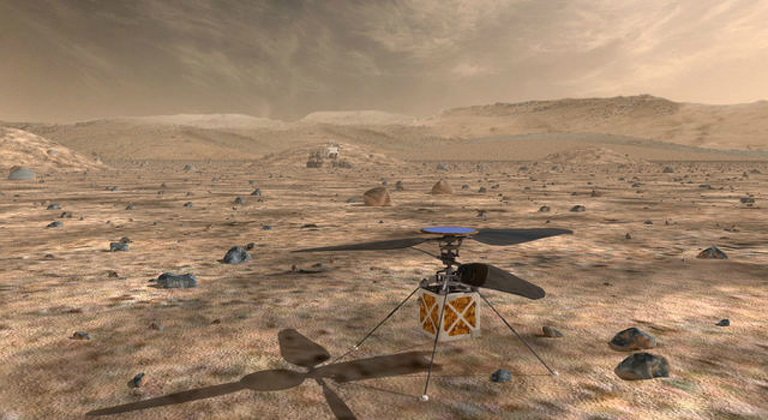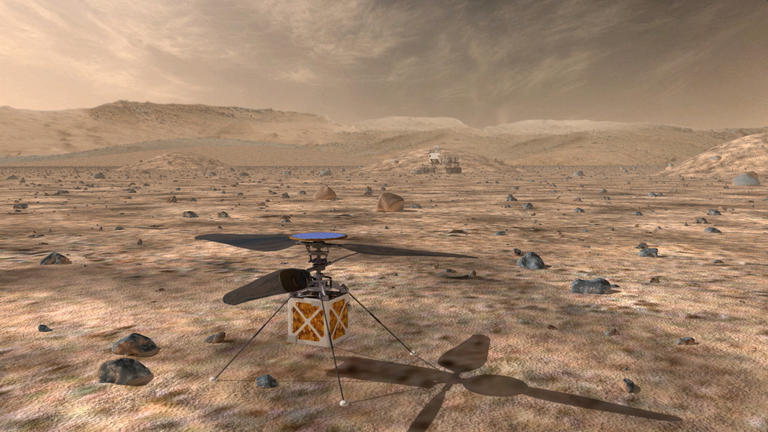Hello friends of #Steemit! A very warm hug for everyone. I hope everyone is well! This post is inspired by the publications that @lemouth of whom I have learned here on this platform, especially on the topics of science and astronomy, that is why I want to start a new topic of astronomical articles, today I will start talking a bit about the mission planned for the planet Tuesday "Mars helicopter will fly on NASA's next Red Planet Rover mission", which aims to study in detail the elements found on this interesting planet, here you can see in detail what this proposed mission is about by NASA, I invite you to observe this article.
The Mars Helicopter, a small autonomous helicopter, will travel with the agency's Mars 2020 rover mission, currently scheduled for launch in July 2020, to demonstrate the viability and potential of vehicles heavier than air on the planet Red.
"NASA has a proud history of firsts," said NASA administrator Jim Bridenstine. "The idea of a helicopter flying through the skies of another planet is exciting: the Mars Helicopter is very promising for our future missions of science, discovery and exploration to Mars."
The representative of EE. UU John Culberson of Texas echoed Bridenstine's appreciation of the impact of American firsts on the future of exploration and discovery.
"It is appropriate for the United States of America to be the first nation in history to fly the first ship heavier than air in another world," said Culberson. "This exciting and visionary achievement will inspire young people across the United States to become scientists and engineers, paving the way for even greater discoveries in the future."

Started in August 2013 as a technology development project at NASA's Jet Propulsion Laboratory (JPL), the Mars Helicopter had to demonstrate that big things could come in small packages. The result of the team's four years of design, testing and redesign weighs just under four pounds (1.8 kilograms). Its fuselage is the size of a softball, and its twin blades that rotate in the opposite direction will bite in the thin Martian atmosphere at nearly 3,000 rpm, roughly 10 times the speed of a helicopter on Earth.
"Exploring the red planet with NASA's Mars Helicopter exemplifies a successful marriage of scientific and technological innovation and is a unique opportunity to advance in the exploration of Mars in the future," said Thomas Zurbuchen, associate administrator of the Directorate of Scientific Mission of NASA at the headquarters of the agency in Washington. "After the Wright brothers demonstrated 117 years ago that controlled, sustained and controlled flight was possible here on Earth, another group of American pioneers can demonstrate that the same thing can be done in another world."
The Mars Helicopter is a technology demonstration that will travel to the red planet with the Mars 2020 rover. It will attempt a controlled flight in the thin atmosphere of Mars, which may allow more ambitious missions in the future.
The helicopter also contains the integrated capabilities needed to operate on Mars, including solar cells to charge its lithium-ion batteries, and a heating mechanism to keep warm during cold Martian nights. But before the helicopter can fly to Mars, it has to get there. It will be attached to the tummy of the Mars 2020 rover.
"The altitude record for a helicopter flying here on Earth is about 40,000 feet." The atmosphere of Mars is only one percent of that of Earth, so when our helicopter is on the Martian surface, it is already in the Earth equivalent to 100,000 feet in height, "said Mimi Aung, manager of the Mars Helicopter project at JPL. "To make it fly at that low atmospheric density, we had to examine everything, make it as light as possible and at the same time be as strong and powerful as possible."
Once the rover is on the surface of the planet, you will find a suitable location to deploy the helicopter from the vehicle and place it on the ground. Then, the vehicle will move away from the helicopter at a safe distance from where it will transmit the commands. After their batteries are charged and a large number of tests are carried out, the controllers on Earth will order the Mars Helicopter to make its first autonomous flight into history.
"We do not have a pilot and the Earth will be several light-minutes away, so there is no way to control this mission in real time," Aung said. "Instead, we have an autonomous capability that can receive and interpret commands from the ground, and then fly the mission by itself."
The complete 30-day flight test campaign will include up to five flights of progressively farther flight distances, up to a few hundred meters, and longer durations of up to 90 seconds, over a period. On its first flight, the helicopter will make a short vertical climb to 10 feet (3 meters), where it will travel for about 30 seconds.
As a technology demonstration, the Mars Helicopter is considered a high risk and high reward project. If it does not work, the mission of Mars 2020 will not be affected. If it works, helicopters can have a real future as low-flying explorers and aerial vehicles to access places not accessible by land.
"The ability to see clearly what lies beyond the next hill is crucial for future explorers," said Zurbuchen. "We already have excellent views of Mars from both the surface and the orbit, with the additional dimension of a bird's eye view from a 'helicopter', we can only imagine what future missions will achieve."Mars 2020 will be launched on an Atlas V rocket from the United Launch Alliance (ULA) from Space Launch Complex 41 at the Cape Canaveral Air Force Station in Florida, and is expected to reach Mars in February 2021.
The rover will conduct geological assessments of its landing site on Mars, determine the habitability of the environment, look for signs of ancient Martian life and evaluate natural resources and hazards for future human explorers. The scientists will use instruments on the mobile phone to identify and collect samples of rock and earth, place them in sealed tubes and leave them on the surface of the planet for their possible return to Earth in a future mission to Mars.
The Mars 2020 Project at JPL in Pasadena, California, manages the development of the rover for the Scientific Mission Directorate at NASA Headquarters in Washington. The NASA Launch Services Program, based at the Kennedy Space Center of the agency in Florida, is responsible for managing the launch.
The record altitude for a helicopter here on Earth is around 12,200 meters. The atmosphere of Mars is 1 percent of that of the Earth, therefore, when our helicopter is on the surface, it will already be at the equivalent of 30,480 meters, "Mimi Aung, project director, said in a statement. at NASA's Jet Propulsion Laboratory.
Overview
Overview
From the Jet Propulsion Laboratory, the California Institute of Technology at NASA has been exploring the potential of sending an airborne rover to accompany the Mars 2020 rover. The main objective of this helicopter is to explore the terrain in front of the vehicle to provide aerial images with a resolution approximately 10 times greater than the orbital images, and thus show the characteristics that can be occluded from the cameras on board.3 The exploration by the small helicopter-drone would allow the rover to go up to three times more per Martian day (sun) .4 The helicopter would fly approximately 3 minutes a day and cover a distance of about 600 m (2,000 feet) .5 It would use autonomous control and communicate with the rover directly after landing.
Description
The helicopter uses counter rotating coaxial rotors approximately 1.1 m in diameter. Its payload would be a high resolution camera pointing downwards for navigation, landing and scientific topography of the terrain, and a communication system to relay data to the rover.The insufficient magnetic field of Mars does not allow the use of a compass for navigation, which would require a solar tracking camera integrated into the visual inertial navigation system of JPL. Some additional elements may include gyroscopes, visual odometry, tilt sensors, altimeter and hazard detectors, and use solar panels to recharge your batteries.
Bibliography :
«NASA is developing a helicopter drone for the Mars 2020 Mission». Business 2 Community. January 27, 2015.
Leone, Dan (November 19, 2015). «Elachi Touts Helicopter Scout for Mars Sample-Caching Rover». SpaceNews Retrieved on November 20, 2015.
Helicopter could be 'Scout' for Mars Rovers. News from NASA. January 22, 2015.
Review on space robotics: towards first level science through space exploration (PDF). And Gao, S Chien - Robotic Science, 2017.
«Crazy Engineering Mars Helicopter Transcript» (PDF). JPL - NASA. January 22, 2015. Retrieved on September 1, 2015.
-Volpe, Richard. «2014 Robotics Activities at JPL» (PDF). Jet Propulsion Laboratory. Retrieved on September 1, 2015.
Estimation of course through Sun Sensing for autonomous navigation. Parth Shah. 2017
Dubois, Chantelle (November 29, 2017). «Drones on Mars? NASA projects will soon be able to use drones for space exploration. " Everything about the circuits.
Berger, Eric (May 24, 2016). "Four lawmakers of savage technologies want NASA to pursue them." ARS Technica. Retrieved on May 24, 2016.


Hi, I found some acronyms/abbreviations in this post. This is how they expand: